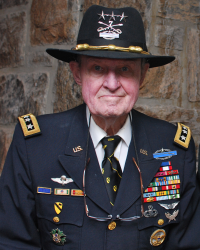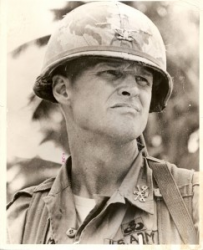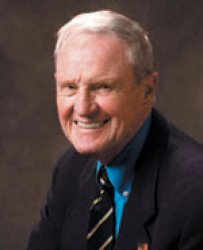
 |
|
|
||
|
Harold Gregory Moore 'Hal' |
||||
|
Graduate, U.S. Military Academy, Class of 1945 Engagements: • Korean War (1950 - 1953)• Vietnam War (1960 - 1973) |
||||
| Biography: | ||||
|
Moore was born on 13 February 1922, in Bardstown, KY. He had wanted to attend the United States Military Academy in West Point, New York, however he found it difficult to be appointed to West Point due to the rural area of his hometown. Moore therefore moved to Washington, D.C., where he graduated high school and attended Brown University for two years. After that, he was appointed to West Point by a Georgia congressman in 1942. He graduated from West Point in early 1945 and attended graduate studies at George Washington University and Harvard University, and achieved a Master's degree in International Relations from the latter. Moore was commissioned as a Second Lieutenant of Infantry in early 1945. He served with the 187th Airborne Infantry Regiment in Japan from 1945 until 1948. In 1948 he was re-assigned to Fort Bragg. While with the 82nd Airborne Division, he volunteered to join the Airborne Test Section, a special unit testing experimental parachutes, and he made some 150 jumps with the section over the next two years. Over the course of his career, he became a master parachutist with over 300 jumps. In 1952 Moore was assigned to the 17th Infantry Regiment of the 7th Infantry Division as a captain in the Korean War. While in Korea, he commanded both a rifle company and a heavy mortar company in combat. He next served as Regimental and then Divisional Assistant Chief-of-Staff, Operations and Plans. In 1954, Moore returned to West Point, this time as a major, and served for three years as an instructor in infantry tactics. While serving as an instructor at West Point, Moore taught then-cadet Norman Schwarzkopf, who called Moore one of his "heroes," and cites Moore as the reason he chose the infantry branch upon graduation. Schwarzkopf later became a General in the U.S. Army and led the UN Coalition forces in the 1991 Gulf War against the Ba'athist Iraq. Moore next attended the Command and General Staff College, followed by a three-year tour in the Office, Chief of Research and Development where his initiative and insights were key to the development of new airborne equipment and airborne/air assault tactics. Following graduation from the Armed Forces Staff College in 1960 Moore served a three-year tour with Headquarters, Allied Forces Northern Europe in Oslo, Norway. In 1964, Lieutenant Colonel Moore completed the course of study at the National War College, while earning a master's degree in International Relations from Harvard University. Moore was transferred to Fort Benning and commanded a battalion in the 11th Air Assault Division, undergoing air assault and air mobility training and tests until July 1965, when the Division was redesignated the 1st Cavalry Division. Lieutenant Colonel Moore as CO of the 1st Battalion, 7th Cavalry (then in the 3rd (Garry Owen) Brigade, 1st Cavalry Division took his unit to South Vietnam, and led it in the famous Battle of Ia Drang. Encircled by enemy soldiers with no clear landing zone (LZ) that would allow them to leave, Moore managed to persevere despite overwhelming odds that led to a sister battalion only two-and-a-half miles away being massacred the next day. Moore's dictum that "there is always one more thing you can do to increase your odds of success" and the courage of his entire command are credited with this astounding outcome. Importantly, despite the fact that Moore's spirited defense led to more than a 4-to-1 ratio between North Vietnamese casualties and U.S. casualties in their first major engagement of the war, Moore considers the battle a draw because the U.S. forces left the area, allowing the North Vietnamese to reassert control. Many consider this early battle a microcosm of the later war. Moore was known as "Yellow Hair" to his troops at the battle at Ia Drang, for his blond hair, and as a tongue-in-cheek homage referencing George Armstrong Custer, commander of the same unit (7th Cavalry) at the Battle of the Little Bighorn just under a century before.[3] Moore was awarded the Distinguished Service Cross for his actions at Ia Drang. After the Battle of the Ia Drang Valley, Moore was promoted to colonel and took over the command of the Garry Owen Brigade. After service in Vietnam, Moore served as Assistant Chief-of-Staff, Operations and Plans of the Eighth Army in South Korea, and Commanding General of the 7th Infantry Division, before rotating back to the US. As Commanding General of the Army Training Center at Fort Ord, California in 1971-1973, he oversaw extensive experimentation in adapting basic and advanced individual training under Project VOLAR in preparation for the end of conscription and the institution of the Modern Volunteer Army. His final assignments took him to the East Coast, as Commanding General of the Military Personnel Records Center, and finally, Deputy Chief of Staff for Personnel, Department of the Army. After his retirement in 1977, Moore served as the Executive President of the Crested Butte Ski Area, Colorado. In June 2009, the 87-year-old Moore attended the formal opening of the National Infantry Museum in Columbus, Georgia. One of the featured exhibits of the museum is a life-size diorama of LZ X-Ray from the Battle of Ia Drang. FAMILY: Moore and his late wife, Julia Compton Moore, have five children and twelve grandchildren.[1] Two of their sons are career Army officers: one a retired lieutenant colonel and another a retired colonel. BOOKS: In 1975, the United States Army Center of Military History published Building a Volunteer Army: The Fort Ord Contribution, by Moore and Lieutenant Colonel Jeff M. Tuten. The 139-page paperback is a monograph concerning the Project VOLAR experiments during Moore's tenure in command of Fort Ord in 1971-1973 in preparation for the end of the draft and the implementation of the Modern Volunteer Army. In 1992 Moore wrote We Were Soldiers Once… And Young with co-author Joseph L. Galloway. The book was adapted into the 2002 film We Were Soldiers, which was filmed at Forts Benning and Hunter Liggett, depicting Moore's command of 1st Battalion, 7th Cavalry, at Fort Benning and in the Battle of Ia Drang. In the film, Moore was played by Mel Gibson, while Galloway was portrayed by Barry Pepper. Moore and Joseph L. Galloway have co-authored another book together, a follow-up to their highly successful first collaboration. We Are Soldiers Still; A Journey Back to the Battlefields of Vietnam was highly anticipated and published in 2008.[7] Moore and Galloway reunited to give an interview on the book at the Pritzker Military Library on September 17, 2008. In 2007 Moore's volunteer driver authored a book on Moore's personal religious journey titled A General's Spiritual Journey. According to the publisher on Amazon.com in the book "Hal Moore opens his heart and soul about the role of faith through his many life experiences. The book is an evocative collection of his memories, as observed and recorded by his friend and driver." In November 2013, Casemate Publishers released Hal Moore: A Soldier Once...and Always, by Mike Guardia, a fully illustrated biography on Moore's life and career. AWARDS:Distinguished Service Cross Army Distinguished Service Medal Legion of Merit (with two bronze oak leaf clusters) Bronze Star (four awards, including two for valor) Air Medal with one silver and three bronze Oak Leaf Clusters in lieu of Numeral 9 Joint Service Commendation Medal Army Commendation Medal (with two bronze oak leaf clusters) American Campaign Medal Asiatic-Pacific Campaign Medal World War II Victory Medal Army of Occupation Medal National Defense Service Medal (with bronze oak leaf cluster) Korean Service Medal with three bronze campaign stars Vietnam Service Medal with three bronze campaign stars Armed Forces Expeditionary Medal Vietnam Cross of Gallantry with Palm (three awards) United Nations Service Medal for Korea Vietnam Campaign Medal Republic of Korea War Service Medal Army Presidential Unit Citation Republic of Korea Presidential Unit Citation Gallantry Cross Unit Citation Vietnam Gallantry Cross Unit Citation with Palm (two awards) Order of Saint Maurice by the National Infantry Association Distinguished Graduate Award from the West Point Association of Graduates Joe Ronnie Hooper Award, 2007 BADGES: Combat Infantryman Badge (2 awards) Basic Army Aviator Badge Master Parachutist Badge Original Air Assault Badge Vietnam Parachutist Badge Office of the Secretary of Defense Identification Badge Army Staff Identification Badge Distinguished Service Cross Citation The President of the United States of America, authorized by Act of Congress, July 9, 1918 (amended by act of July 25, 1963), takes pleasure in presenting the Distinguished Service Cross to Colonel (Infantry), [then Lieutenant Colonel] Harold Gregory Moore, Jr. (ASN: 0-27678), United States Army, for extraordinary heroism in connection with military operations against an armed hostile force in the Republic of Vietnam. During the period 14 through 16 November 1965, Colonel Moore, Commanding Officer, 1st Battalion, 7th Cavalry, 1st Cavalry Division (Airmobile), was participating with his unit in a vital search and destroy operation in the la Drang Valley, Republic of Vietnam. Upon entering the landing zone with the first rifle company, Colonel Moore personally commenced the fire-fight to gain control of the zone by placing accurate fire upon the Viet Cong from an exposed position in his hovering helicopter. Throughout the initial assault phase, Colonel Moore repeatedly exposed himself to intense hostile fire to insure the proper and expedient deployment of friendly troops. By his constant movement and repeated exposure to this insurgent fire, Colonel Moore, with complete disregard for his own personal safety, set the standard for his combat troops by a courageous display of "leadership by example" which characterized all his actions throughout the long and deadly battle. Inspired by his constant presence and active participation against the overwhelming insurgent hordes, the friendly forces solidified their perimeter defenses and repulsed numerous Viet Cong assaults. On 15 November 1965, the embattled battalion was again attacked by a three-pronged insurgent assault aimed at surrounding and destroying the friendly forces in one great advance. With great skill and foresight, Colonel Moore moved from position to position, directing accurate fire and giving moral support to the defending forces. By his successful predictions of insurgent attack plans, he was able to thwart all their efforts by directing barrages of small arms, mortar, and artillery fire in conjunction with devastating air strikes against Viet Cong positions and attack zones. As the grueling battle continued into the third day, another large Viet Cong strike was repulsed through Colonel Moore's ability to shift men and firepower at a moment's notice against the savage, last-ditch efforts of the insurgents to break through the friendly positions. Colonel Moore's battalion, inspired by his superb leadership, combat participation, and moral support, finally decimate the well-trained and numerically superior Viet Cong force so decidedly that they withdrew in defeat, leaving over 800 of their dead on the battlefield, and resulting in a great victory for the 1st Battalion. Colonel Moore's extraordinary heroism and gallantry in action were in keeping with the highest tradition of the United States Army and reflect great credit upon himself and the military service. General Orders: Headquarters, U.S. Army, Pacific, General Orders No. 126 (June 1, 1966) Death and Burial Lieutenant General Harold Gregory Moore died on 10 February 2017. He is buried at the Fort Benning Post Cemetery in Fort Benning, Muscogee County, GA. |
||||
| Honoree ID: 222439 | Created by: bchesarek | |||
Ribbons
Medals
Badges
Honoree Photos
 |  |  |
 |  |
 |


